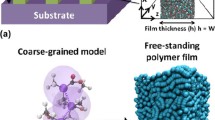Abstract:
A simple and predictive model is put forward explaining the experimentally observed substantial shift of the glass transition temperature, T g, of sufficiently thin polymer films. It focuses on the limit of small molecular weight, where geometrical `finite size' effects on the chain conformation can be ruled out. The model is based on the idea that the polymer freezes due to memory effects in the viscoelastic eigenmodes of the film, which are affected by the proximity of the boundaries. The elastic modulus of the polymer at the glass transition turns out to be the only fitting parameter. Quantitative agreement is obtained with our experimental results on short chain polystyrene (M W = 2 kg/mol), as well as with earlier results obtained with larger molecules. Furthermore, the model naturally accounts for the weak dependence of the shift of T g upon the molecular weight. It explains why supported films must be thinner than free standing ones to yield the same shift, and why the latter depends upon the chemical properties of the substrate. Generalizations for arbitrary experimental geometries are straightforward.
Similar content being viewed by others
Author information
Authors and Affiliations
Additional information
Received 23 April 2001
Rights and permissions
About this article
Cite this article
Herminghaus, S., Jacobs, K. & Seemann, R. The glass transition of thin polymer films: some questions, and a possible answer. Eur. Phys. J. E 5 (Suppl 1), 531–538 (2001). https://doi.org/10.1007/s101890170036
Issue Date:
DOI: https://doi.org/10.1007/s101890170036




